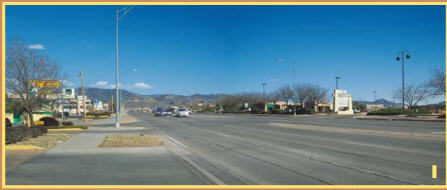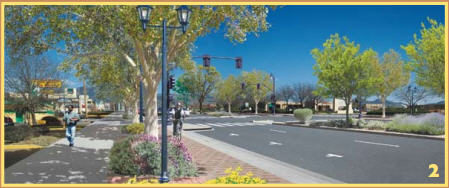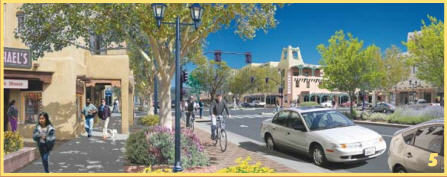Steve Price: Urban Advantage, presented a “time lapse photography”, showing the evolution of St. Mike’s in four steps…

Images courtesy of Steve Price, Urban Advantage, Inc

 For the last fifty years the dominant street form for commercial environments in America has been the auto-oriented strip arterial. These are places where the car is king, where formal planning is almost exclusively about managing car movements and car storage, and where formal consideration for the needs of pedestrians is largely absent. Almost every town now has these strips—streets dominated by parking lots, driveways, wide roadways, tall cobra-headed streetlights, big intersections, and an almost total lack of visible people outside of cars. Parking requirements for commercial uses almost always mandate more parking spaces than ever will be used, so asphalt dominates. Cars travel at 40 mph, which means that collisions with pedestrians are usually deadly—the times when parents didn’t worry about children bicycling to the store are long gone.
For the last fifty years the dominant street form for commercial environments in America has been the auto-oriented strip arterial. These are places where the car is king, where formal planning is almost exclusively about managing car movements and car storage, and where formal consideration for the needs of pedestrians is largely absent. Almost every town now has these strips—streets dominated by parking lots, driveways, wide roadways, tall cobra-headed streetlights, big intersections, and an almost total lack of visible people outside of cars. Parking requirements for commercial uses almost always mandate more parking spaces than ever will be used, so asphalt dominates. Cars travel at 40 mph, which means that collisions with pedestrians are usually deadly—the times when parents didn’t worry about children bicycling to the store are long gone.
When we create our before-and-after street transformations such as the one we did of St. Michael’s Drive on this page, we almost never encounter citizens who express preference for the before view. And we are never asked by developers of these kinds of environments to create visualizations to help market them. They know that photo-realistic visualizations of their auto-oriented plans will not sell the product. Citizens may criticize the “after” images we come up with by arguing about the style of architecture we show, or the appropriateness of street tree species, or whether people really dress like that in their town, but we consider these healthy topics for debate. The important thing is whether the vision shows a formal concern for human welfare: Are buildings accessible from sidewalks? Are sidewalks wide enough and protected enough from car movements to feel comfortable and safe? Can children and seniors—not just daring young athletic adults—safely and comfortably bicycle to stores and services? Are buildings and signage scaled to be seen at slow walking and bicycling speeds, not just whizzed by at 45 mph? Is the street beautiful—does it function as an attractive public space that people will enjoy being in?
It is estimated that during the next ten years America will add another 33 million people. Where will they live? Often you hear citizens say that our towns and cities can’t accommodate more people—our cities are “all built out.” Were people saying that about Paris in the 12th century? or the 13th? or the 17th? or the 19th? Does St. Michael’s Drive with all its asphalt look “all built out?” Cities don’t get “built out.” Cities are living things, and living things dynamically evolve. Once we get over the idea that our communities have an end state where improvement stops, then we will realize how much more potential they have.
The demand for houses is shrinking, but the demand for apartments is growing. Professor Arthur C. Nelson of the University of Utah thinks the rental share of housing will surpass 41% by 2020. If you look around most attractive walkable commercial areas you will see that there are usually multiple housing types nearby. The apartment, granny flat, and row house dwellers help keep the coffee shops and restaurants alive. Nelson thinks that we should be looking to auto-dominated strips like St. Michael’s Drive as the new centers of pedestrian friendly development.
Complete town centers can fit into many big box store centers. An historic center like that surrounding Santa Fe Plaza would easily fit into any one of the commercial stretches along St. Michael’s Drive. And since such new development would be on the linear drive, it could easily be served by transit. The demand for transit-oriented development over the next 30 years will grow to 68 million units, according to Nelson. Along St. Michael’s Drive such development could happen without bulldozing any existing houses. In fact present house-dwellers could now have stores and services within walking distance.
Strip arterials with acres and acres of under-utilized parking lots have room to build new walkable neighborhoods complete with greener streets, calmer traffic, comfortable sidewalks, local coffee shops, convenient housing, accessible transit, and safe bicycling throughout—all enriching the experience of living locally. A key to local prosperity and civic pride is for the community to share a common vision for the future, and be willing to support the plans and regulations that would bring the vision about. St. Michael’s Drive can be a safer, more hospitable, and more beautiful place if Santa Feans want it to be.
Steve Price is with Urban Advantage, Inc. Berkeley, CA 510.486.0427, email shprice@urban-advantage.com